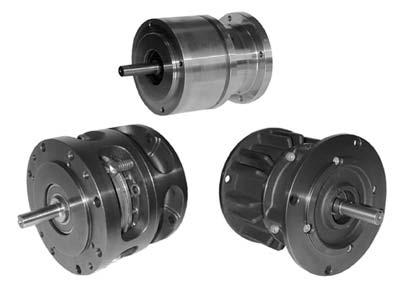As the result of tests conducted by an independent laboratory, Nexen Group, Inc. identified seven key performance-related and cost-saving advantages of air-actuated clutch-brakes over electric units of comparable size.
The tests were conducted by Huntingdon Engineering & Environmental, Inc. of St. Paul, Minnesota. Units tested were the Nexen Air Champ FMCBE-625 air clutch-brake and a comparable electric clutch-brake.
When looking at life performance, air-engaged clutches-brakes, come out way ahead. They typically have more than twice the life cycle of electrical clutches-brakes.
The results clearly show that air-actuated clutch-brakes outperform electric clutch-brakes, and offer superior performance. In fact, Air Champ® clutch-brakes typically have twice the friction facing life cycle of electrical.
Air Champ® vs. Electric: Seven Comparison Points
• Response Time: Response time is the increment of time in seconds from the time the power is turned on or off at the control valve, or power supply, to the time the clutch or brake responds with (full load) torque, or disengages and the torque begins to decay.
The time to 100% clutch torque for the air clutch was 40% faster than for the electric clutch. The time to zero torque (brake on) for the air clutch was 42% faster than for the electric.
• Torque Output: Tests focused on the torque output of NEMA 56 C-flanged air and electric clutch-brakes.
The electric clutch transmitted only 54% of its rated torque. In comparison, the Nexen clutch transmitted up to 145% more torque under the same conditions, because it operated at a lower temperature. The higher operating temperature of the electric clutch affected torque fade, as well.
• Facing Life Comparison: The estimated facing life of air and electric units were determined in a calculation using the
1) volume of usable facing material,
2) friction materials wear rate,
3) work energy capacity, and
4) kinetic energy-per-cycle for a specific application.
The results indicated that the Nexen clutch-brake had considerably more available friction facing volume, which translates into more horsepower-hours of work. While the friction facings on the Nexen unit were worn away partially, they still had sufficient material left to create the required friction against the facings to start or stop the load on the output shaft.
The friction facings on the electric unit, on the other hand, were worn so far down that there was metal-to-metal contact.
• Thermal Horsepower: The test also revealed that the air clutch-brake consistently operated at lower temperatures compared to the electric unit. Nexen's FMCBE-625 model has a rated thermal horsepower of 0.14. A comparable electric unit has a rated thermal horsepower of 0.10.
• Repair Costs: A test to determine the number of cycles to failure was conducted, and the Nexen clutch-brake was the overwhelming winner, more than doubling the number of cycles achieved by the electric unit. Additionally, replacement part costs published by the manufacturers showed that the air unit is less expensive to repair.
Nexen engineers conducted additional analysis to acquire comparative data on Energy Consumption and Unit Cost Savings. Here's what they found:
• Energy Consumption: Using Friction Facing Life comparison information gathered in a conveyor system application, along with power consumption data published in the electric clutch-brake manufacturer's catalog, it was discovered that the electric unit coil consumed 2.5 times more energy than the compressor that provided air to the Nexen Air Champ.
• Unit Cost Savings: Air Champ clutch-brakes cost up to 10% less than comparable electric units.

















